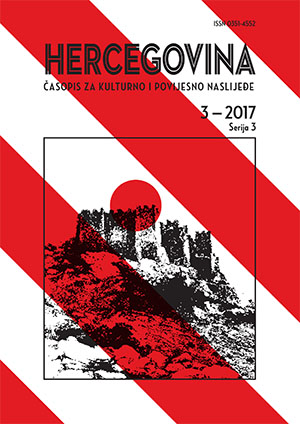GOTIČKA UMJETNOST U PRIMORJU, GORSKOJ ŽUPI
I RADOBILJI U VREMENU HERCEGA STJEPANA VUKČIĆA
KOSAČE - IZMEĐU STVARNOSTI I PREDAJE
Gothic Art in Primorje, Gorska Zupa and Radobilja
in the Time of the Herzog Stjepan Vukcic Kosaca -
between Reality and Folk Tradition
Author(s): Marinko TomasovićSubject(s): History, Fine Arts / Performing Arts, Cultural history, 15th Century
Published by: Filozofski fakultet Sveučilišta u Mostaru
Keywords: Gothic architecture of churches; liturgical vessels; relief crosses; painted crosses; tombstones (stecaks); grave plaques; triangular gables; cross vaults; fortresses; Herzog's tower; Erceg's hills;
Summary/Abstract: Gothic art in Primorje (Krajina), Gorska Zupa and Radobilja was emphasized during the rule of the Herzog Stjepan Vukcic Kosaca over the territories between Cetina and Neretva, around 1440-1416. Churches with rectangular shrine, mostly with partitions, mentioned in the Ottoman 16th-17th c. prove that they were built in the 15th century. The buildings were erected according to the model of the Franciscan churches of Our Lady in Makarska and Zaostrog from the 15th century. The Makarska church even after the destruction in the 16th and 17th c., preserved the aisle with a rectangular shrine. Such is St. Nicholas'church in Gornja Brela and reconstructed St. Cosmas and Damian church in Rogoznica, mentioned in 1461. In the church of St. Luke in Kucici the foundations of an earlier church with a rectangular apse were discovered. During Stjepan Kosaca's rule in the Omis hinterland there were built other churches, mentioned in the list from 1625. In Gorska Zupa worth mentioning is St. Peter in Dusina from 1585. In Lower Neretva area, St. Stjepan in Slivno Ravno has preserved only a sanctuary, while the foundations of St. Nichola's in Borovci prove its Gothic construction. Theinscription with the name of the Herzog Stjepan from1466 indicates that he constructed the church in Drasnice to honor the saint of the same name. The top door reliefs with relief crosses in Tucepi and Borovci belong to thechurches from the 15th century, as well as the as persorium of St. Luke's church in Kucici. At the beginning of the 15th century, St. Juraj in Tucepi and St. Ivan in Podaca were painted with dedicated crosses, inside squares and decorated circles. Their tombstones and plaques are also worth mentioning. The tombstones were related to Vlachs, and plaques with heraldic features to the local ethnic groups.The number of Vlachs was significant at the time of the Herzog Stjepan, when most of the tombstones were made.In the Omis fortress of Pec, according to tradition, the Herzog had a residence, but he also owned Starigrad and Visuc up the river. In Radobilja he intended to raise thebridge across the river and a fortress, which the Venetiansin 1457 were seeking to destruct. He also owned Vrgoracin Gorska Zupa, whose wall had a Gothic crown and towersat the bottom. Additionally, there is Vratar on the rightside of the Neretva, and Brstanik near Opuzen, importantin the war with Dubrovnik from 1451 to 1454. The Herzog'sTower was preserved in Gornja Brela. It is an indication ofthe rule of Kosacas, as well as the Erceg's hill above Makarska,erected as a part of town fortification plan. Ermitage along the Cetina river from 5th- 6th c. is linked to the Herzog,as a remembrance of his rule (1440-1444) in Omis,as well as the interpretation of the Venetian coat of arms from the 17th century as his. The tradition was indirectly linked to the Herzog Stjepan in the name of the Illyrian fortress Matijasevica in Zivogosce, relating it to the Croat-Hungarian king Matija Korvin. Both rulers were alliesin 1463 in the battles to return Bosnia from the Ottomans.
Journal: Hercegovina. Časopis za kulturno i povijesno naslijeđe (Do 2018)
- Issue Year: 2017
- Issue No: 3
- Page Range: 273-329
- Page Count: 57
- Language: Croatian

